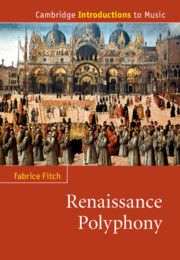Book contents
- Cambridge Introductions to Music
- Cambridge Introductions to Music Renaissance Polyphony
- Copyright page
- Dedication
- Contents
- Illustrations
- Figures
- Tables
- Music examples
- Acknowledgements
- Note on the music examples
- Note on the bibliography
- Abbreviations
- Chapter 1 Introducing Renaissance polyphony
- Chapter 2 Making polyphony: sources and practice
- Chapter 3 Makers of polyphony
- Chapter 4 Pitch: an overview
- Chapter 5 Voice-names, ranges, and functions
- Chapter 6 Mensural notation, duration, and metre
- Chapter 7 Genre, texts, forms
- Chapter 8 ‘Cantus magnus’: music for the Mass
- Chapter 9 ‘Cantus mediocris’: the motet
- Chapter 10 ‘Cantus parvus’: secular music
- Chapter 11 Scoring, texture, scale
- Chapter 12 Understanding musical borrowing
- Chapter 13 Canons, puzzles, games
- Chapter 14 Performance practice: a brief introduction
- Notes
- Glossary
- Bibliography
- Index of compositions
- General index
- Cambridge Introductions to Music
Chapter 11 - Scoring, texture, scale
Published online by Cambridge University Press: 13 August 2020
- Cambridge Introductions to Music
- Cambridge Introductions to Music Renaissance Polyphony
- Copyright page
- Dedication
- Contents
- Illustrations
- Figures
- Tables
- Music examples
- Acknowledgements
- Note on the music examples
- Note on the bibliography
- Abbreviations
- Chapter 1 Introducing Renaissance polyphony
- Chapter 2 Making polyphony: sources and practice
- Chapter 3 Makers of polyphony
- Chapter 4 Pitch: an overview
- Chapter 5 Voice-names, ranges, and functions
- Chapter 6 Mensural notation, duration, and metre
- Chapter 7 Genre, texts, forms
- Chapter 8 ‘Cantus magnus’: music for the Mass
- Chapter 9 ‘Cantus mediocris’: the motet
- Chapter 10 ‘Cantus parvus’: secular music
- Chapter 11 Scoring, texture, scale
- Chapter 12 Understanding musical borrowing
- Chapter 13 Canons, puzzles, games
- Chapter 14 Performance practice: a brief introduction
- Notes
- Glossary
- Bibliography
- Index of compositions
- General index
- Cambridge Introductions to Music
Summary
This chapter rejoins the methodology of normative approaches to voice-ranges and functions sketched in Chapter 5. Renaissance polyphony is considered in terms of the related compositional determinants of scoring, texture, and scale. The principal topics are: fifteenth-century pieces that lie outside the normative parameters seen in Chapter 5; the rise of imitation, viewed as a sub-category of texture, through to its paradigmatic status in the sixteenth century; the polyphony of the English Renaissance, much of whose earlier history develops along very different lines to continental music; and finally, the changes of approach to scale in Renaissance polyphony, from the ‘out-sized’ cyclic Masses at the turn of the sixteenth century to the growing emphasis on the number of voices, culminating in the ‘sonic blockbusters’ fashionable in European courts at the end of the century, whose most enduring manifestation is Tallis’ forty-part motet ‘Spem in alium’.
- Type
- Chapter
- Information
- Renaissance Polyphony , pp. 141 - 167Publisher: Cambridge University PressPrint publication year: 2020

